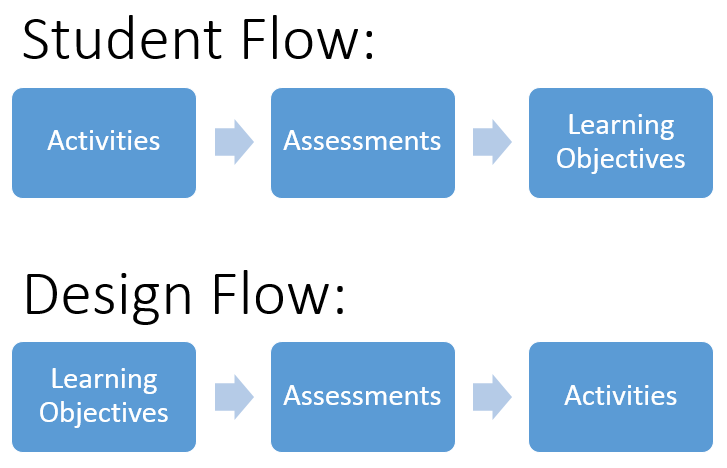Course Alignment Triangle
Have you heard of the Fire Triangle?
For fire to exist, it must have, in the correct proportion, each of three elements: Fuel, Heat, and Oxygen. Without any one of these elements, a fire cannot burn. No element is more important than the other. Firefighters use this fire triangle concept to extinguish fires based on a given situation. By removing one of the elements, firefighters can destroy a fire.

In Dee Fink's book, Creating Significant Learning Experiences (2003), he describes and visualizes the concept of properly aligning assessments with learning goals as represented in the following image.

In Fink's model, each of the three elements is equally important and required for significant learning to exist. With a break-down in any of the elements, students will have difficulty achieving learning outcomes as desired. For example, even if assessments are properly constructed and aligned to learning outcomes, students will have difficulty completing outcomes if learning activities are not aligned with the assessments.
from Fink- A Self-Directed Guide to Designing Courses for Significant Learning

As with the fire triangle, if any of the design elements are broken, the course or lesson will not function effectively.
The close and integrated relationships of learning outcomes, properly aligned assessments, and relevant learning activities provide the foundation to Backward Design. Due to the importance of these relationships, good planning and using design tools can make a large difference in the final product.
What does Alignment mean? For a given learning objective, the assessment must be designed to truly reflect student learning. Likewise, activities must properly prepare students for the assessment.
As example, consider one learning objective (LO) from a lesson on learning to tune an ukulele:
- Learning Objective 1- Students will properly attach electronic tuner to an ukulele
- Assessment- Multiple Choice Quiz
- Activity- View a video demonstration of how to attach a tuner to an ukulele
In this case, the activity (video demo) may very well help students learn how to attach a tuner to their ukulele, but the assessment is not properly aligned to the learning objective. That is, while the student may or may not have achieved the learning objective, we have no way of knowing by assessing using a multiple choice quiz. The LO states "students will properly attach tuner to an ukulele." This LO requires action on the part of the student which is not demonstrable via a quiz. Using Fink's diagram, we might visualize the mis-alignment as:

Conceptually, this means that in order to best design a learning unit for a given learning objective(s) we must:
- ensure authentic assessment of if the results are achieved
- ensure activities and instructions which properly prepare students to successfully complete the assessments
Backward Design
As you design your learning unit, do keep in mind how well learning objectives, activities, and assessments are aligned. Are these elements performing as you desire? The backward design process, which is the basis of most every course design model, can help you work through aligning learning objectives, assessments, and activities. The term and concept of backward design as applied to course design were made popular by Jay McTighe and Grant Wiggins in their book titled Understanding by Design.
Backward design is a simple framework which suggest we should work backward from the results we wish to observe in our students. Students access a learning unit first via activities for preparation then move to assessments for evaluation in order to demonstrate achievement of the learning objectives. In backward design, the designer/teacher, ensures a logical and effective process by reversing this flow.

For your learning unit for Week 5, ask yourself these questions:
- What do I want my students to learn? (Learning Objectives)
- How will I know if they did achieve these objectives? (Assessments)
- What must the students do in order to achieve the objectives (Activities)
Sample Learning Unit Design- Tune an Ukulele
Review the following learning unit designed based on LO alignment and backward design concepts. Built on a simple and approachable topic (tuning an ukulele), the following examples demonstrate how you might approach designing your learning unit for Week 5.
Description: The following Tune-an-Ukulele lesson is envisioned as one small unit of a Music Appreciation class. The course is blended with about 40% of sessions taking place in an online or digital format. The learning unit occurs over one face-face session plus personal time as needed by the student to work through the activities and complete assessments.
The following table outlines all of the Learning Objectives, Assessments, and Activities for the unit.
Goal- Tune an Out-of-tune ukulele with an electronic tuner |
|||
Outcomes |
Assessments |
Activities |
NOTES |
Learning Objectives:
|
|
|
|
Careful attention is given to creating assessments which authentically evaluate a student's learning. Each activity is designed to be directly related to an assessment. In this way, we can be sure that we are evaluating student completion of the learning objectives as well as providing the necessary instructions and resources for learning to take place. All components in the above plan are interrelated and connected in purposeful ways.
A visual representation of these connections may be shown as the following:

Sample Planning Guides
Word Document- Tune an Ukulele Design
Word Outline- Tune an Ukulele Design
Design Map- Tune an Ukulele Design
Blank Planning Documents
Word Document- Course Alignment Guide
Word Document- Course Alignment Outline
The above planning guides are suggestions. Use any tool you find effective.